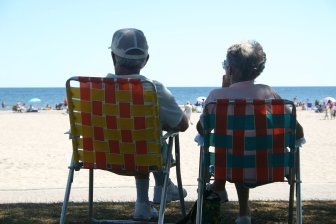Just outside Lakefield, Ont., Paluski Boats Ltd. manufacturer of canoes and kayaks is nestled in cottage country.

Owner Graham Wilkins says it’s one of a few companies in Canada to build watercraft with a process called rotomoulding.
“It starts out as a polyethylene dust almost. It’s ground quite fine,” said Wilkins.”So it flows inside the aluminum moulds and as the machine heats, the dust glues itself against the aluminum and each layer builds on top of each other.”
Three layers are added to a mould and heated for durability, stability and flotation, he said. Most are heated to between 350 and 400 F.
“There is a recipe for each boat that includes the weight of the poly, the amount of time it cooks and when it tilts back and forth,” said Wilkins.
Picture a large metal tube on a tilting rotisserie. Hence, the name rotomoulding. He said this process makes for a stronger kayak that lasts longer than one pressed and formed from a single sheet of plastic.
In all, Wilkins said it takes about two hours to cook and cool a kayak. At their facility they churn out about four kayaks and four canoes daily.
Once the watercraft comes out of the ‘oven,’ the top of the boat and holes for any seats are cut while the plastic is still warm. Wilkins said seats and end caps, or any additions, are made from the scraps of other canoes and kayaks.

Get breaking National news
“All of the offcuts get sent back to the supplier that supplies us with the polyethylene. They grind it up, add the black pigment and we use exactly the same plastic ground-up to create our component parts,” he said. “So there is no waste.”
The company was started in the ’80s, first as a boat repair and fibreglass manufacturer. Now, it produces rotomoulded boats on site with retail company Adventure Outfitters.
Wilkins, no stranger to the water, was on the Canadian national rowing team. He eventually turned that passion into a business.
Now, he said, a boom in boating interest during the pandemic made for two of the busiest years since they opened.
“We’ve been so busy that we haven’t had our plant shut down,” he said. “We try to have it in August but for the past two years we haven’t had a plant shut down until October or November.”
He isn’t alone as other outdoor equipment retailers have had business boom during the pandemic. Tori Silvera, general manager at Wild Rock Outfitters Inc. in Peterborough, On., said more people were turning to outdoor activities while COVID-19 restrictions were in place.
“We’ve felt extremely lucky to be in an industry that could thrive in a pandemic,” she said. “Sales of canoes, kayaks, and SUPs were high as folks worked from the cottage or didn’t work at all,” she said.
She noted bike and boat sales are starting to level-out and people are now focusing on those smaller camping essentials.
“Folks often ask where things are made, particularly with footwear and clothing, and will give a little extra consideration to items that are made or designed in Canada, Fair Trade, or sustainable,” said Silvera.
Wilkins agreed and said he has noticed more people looking for products made in Canada.
“We have certainly seen, in the last two years, a change from being concerned about just getting the lowest price and more of a concern about the quality of a product and getting a Canadian-made product,” he said.
Meanwhile, back at the Paluski warehouse, we are almost through our boat-building process. Seats and component parts are added and edges are smoothed and finished. Then, just add water — or not.
“My favourite story is once I saw a family portaging with one of our boats and they had overloaded the boat so much they had it on wheels. The kids were still inside going down the trail,” said Wilkins.
“They were using it like a wheelbarrow, so you know it is durable and seeing things like that is one of my favourite parts about doing this.”








Comments